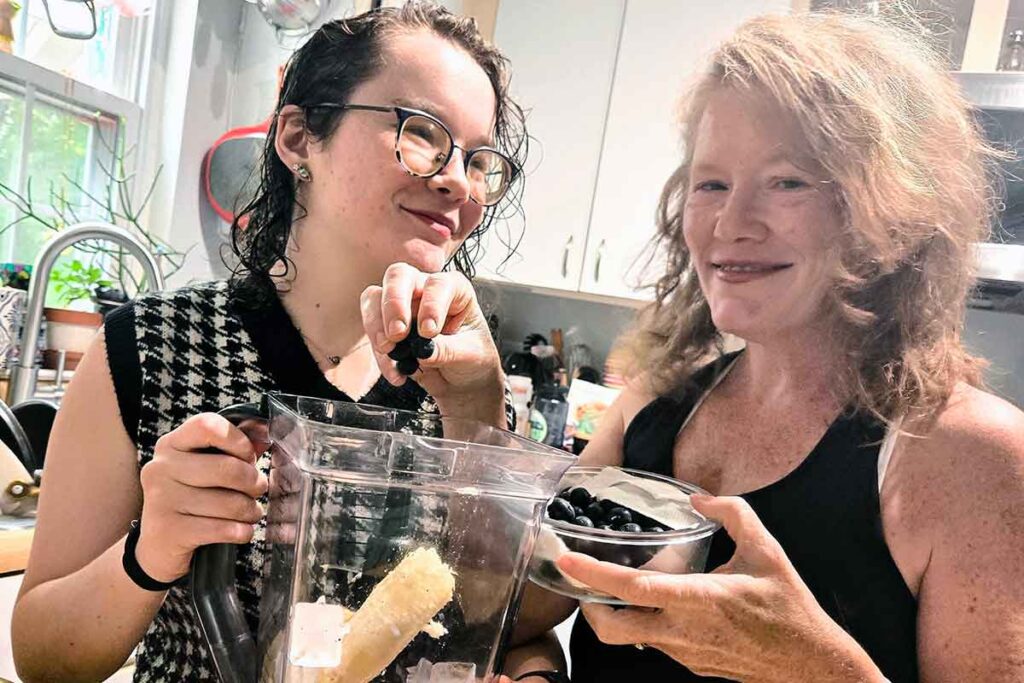Ever since learning about the almond mom category, I’ve grown more aware of my relationship to food. I’ve started thinking of food, not in terms of how many calories it has, but about how much energy it will give me and how it will make my body feel. I’ve noticed how much I worry about eating too much.
With my daughter home from her first year of college, I’m careful about how I talk about food, too. Learning how to avoid almond mom tendencies in myself is a lot of work.
OK — maybe it’s not that hard. The actual behavior changes don’t take much effort. It’s just rearranging your mindset that can feel difficult.
Creating a healthier environment for your kids, even your adult ones, starts with mindfulness and intention. Here’s how you can avoid falling into these patterns.
Avoid Almond Mom Tendencies in 5 Steps
1. Model a Positive Relationship With Food
Show your kids that food is fuel and enjoyment, not something to fear. Avoid labeling food as “good” or “bad.”
I have found that adopting this approach to food doesn’t happen overnight. I started slowly, by just noticing how different foods made me feel. I noticed that high-sugar chips and yogurts really depleted my energy. Too much peanut butter makes me feel sick. But apples and oranges satisfy my cravings. And fresh blueberries taste awesome.
Now, after a couple of months, I find that I gravitate to the food that gives me energy. I might have a chip or 2, but I know it’s not going to feel good if I have more. I’m not labeling it as bad; I’m listening to what my body really wants, and it’s happening naturally. And that feels good.
2. Listen to Your Kids’ Hunger Cues
Trust that your children know when they’re hungry or full. Encourage them to eat when they’re hungry and stop when they’re not.
This can be a tough one if you grew up in a ‘clean your plate’ and a ‘don’t waste food’ household. I find encouraging my kids to fill their own plates works well. Learning to listen to my own stomach is much harder to do. But I find that giving my body the chance to determine what I eat, not my fear of being fat, helps me feel calmer, less worried, and a better mom all around.
3. Focus on Strength, Not Size
Teach your kids to appreciate what their bodies can do rather than how they look. Celebrate achievements like running faster or climbing higher, instead of focusing on appearances.
I’ve started doing this internally, as well. Instead of working out to burn calories (sorry, Jane Fonda!), I stretch because it feels good, run because it’s fun, or do a dance workout because I find it invigorating.
4. Stop Body Talk
Avoid making even positive comments about your body, your children’s bodies, or anyone else’s. Talking about weight, even casually, can plant seeds of insecurity.
“Oh, you lost weight! You look fantastic!” seems like a positive statement. But it can actually feel very uncomfortable. I remember an old family member who used to say that to me every time he saw me. I felt under scrutiny, and like I must always be needing improvement.
5. Prioritize Balance
Teach your kids the importance of balance. Show them that there’s room for fruits, vegetables, and cookies in a healthy diet. Model focusing on how your body feels, including how yummy a cookie tastes, and enjoying eating all the food types. Avoid restricting or binging if you can.
Need a Parenting Refresher Course?
As if we ever went to school for this in the first place!
It’s Not Too Late to Change
Whether or not you believe you have almond mom tendencies, these 5 behaviors can help foster a safe, non-judgmental environment. By showing kindness toward yourself, you’re modeling the same for your kids.
And who doesn’t want to see a world where food is simply enjoyed, without guilt or shame? I even noticed that eating cookies and ice cream for dessert didn’t kill my waistline, as long as I’m paying attention to my body. This is a revelation. A delicious one.
